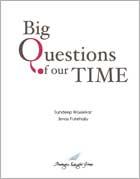In the Post Natural Evolution World
 |
May, 2010
By Sundeep Waslekar
|
These quotes are used as watermarks in the first synthetic cell developed by the J Craig Venter Institute and announced on May 20, 2010. "To Live, To Err, To Fall, To Triumph, To Recreate Life Out Of Life." - James Joyce; "See Things Not As They Are, But As They Might Be.�€- American Prometheus; "What I Cannot Build, I Cannot Understand." - Richard Feynman.
Craig Venter has been a living embodiment of the spirit articulated in these quotes. He mapped the human genome code in February 2001, three years ahead of a public project. In 2007, his institute successfully transplanted the genome of one bacterium into another whereby the recipient bacterium acquired the property of the host bacteria. Finally, in May 2010, the institute created a synthetic bacteria cell in a laboratory and transplanted it into another bacterium where it began to replicate itself.
The institute is funded by Synthetic Genomics, Craig Venter�€™s own business company and the US Department of Energy. Venter�€™s Synthetics Genomics Incorporated has a close tie-up with Exxon Mobil and BP, besides some venture capital companies. Thus, there is a financial bond between genomics research at the Craig Venter Institute and main players in the energy sector. The development of the new self-replicating bacteria seems to be driven by the needs of the energy sector. One set of objectives relate to the invention of bio-fuels. Another set of objectives relate to developing bacteria capable of absorbing CO2 from the atmosphere so that the negative climate change impact of emissions, by transport and other gas consuming industries, is minimised. The institute is also engaged in developing a microbe capable of producing hydrogen. Its mission statement for this project says:
�€œThe goal of our research is to develop a microbe that will form the basis for a viable, cost-effective, photo-biological process to produce renewable hydrogen fuel. By combining the properties of two microorganisms�€”cyano-bacteria and photosynthetic bacteria�€”we hope to develop a novel, hybrid microbe with two highly desirable traits not found together in nature: the ability to produce hydrogen in the presence of oxygen, using water as the feedstock.�€
Even though the primary objective is to service the energy sector, the synthetic genome experiment will undoubtedly create viruses and other by-products useful for the health sector. Some fear, quite justifiably, that the invention of self-replicating bacteria can be used for developing biological weapons. A century ago, an atom was dissected for civilian purposes but the defence establishment used this knowledge to create the most deadly weapon known to man. In order to use a thermo-nuclear weapon, someone has to take a decision and hopefully debate it with a group of advisers before implementing it. Self-replicating bacteria, if produced for military purposes, will not need their creator�€™s or user�€™s permission to spread. Thus, the invention by Craig Venter may advance humanity to a level never imagined during six million years of natural evolution. It may also cause extinction of humanity with one mistake, however intended or unintended.
In either case, the world is no longer what it used to be. Craig Venter and his team have progressed from reading a genome code to writing one. Today they are the only ones capable of doing so. However, once technology is out of the bottle it spreads at a fast pace. In 2001, Venter read the human genome code by spending millions of dollars. By 2011, Oxford University will provide a facility capable of reading anyone�€™s genome code for less than $1000. Similarly, Venter produced a synthetic, self-replicating bacterial cell for $40 million in 2010. We can�€™t be sure who will produce it for $40,000 or even $4000 in 2020.
The J Craig Venter Institute is to biology in the early twenty first century, what the Cavendish Laboratory was to physics in the early twentieth century. The discovery of the electron by JJ Thomson, the invention of the Cloud chamber by Charles Wilson, the discovery of artificial nuclear fission by Rutherford are examples of the extraordinary advances in experimental techniques at Cavendish which ushered in what became known as modern physics. They also gave birth to nuclear weapons, capable of destroying the planet earth several times over.
Just as we cannot blame the Cavendish Laboratory for Hiroshima and Nagasaki, but should rather thank it for advancing physics, we cannot blame the J Craig Venter Institute for the use of a future biological weapons, but rather thank it for advancing biology and genomics. However, there is a lesson to be drawn from the misuse of Cavendish successes by power-hungry politicians. Science has progressed in the last 200-300 years but the nature of politics has remained as selfish, manipulative and greedy as ever. The great challenge before us is how to manage our politics in the post natural evolution world.
Related Publications
-
.jpg&maxw=50)
Big Questions of Our time: The World Speaks, 2016
Download:Big Questions of Our time: The World Speaks _Full Report
-

-

Second Freedom South Asian Challenge 2005-2025, 2005
read more
Download:Second Freedom South Asian Challenge 2005-2025 Full Report
Related latest News
Related Conferences Reports
-

Global Challenges Conference, October 2016
Download:Global Challenges Conference Report
-

Conference on Responsibility to the Future: Business, Peace and Sustainability, June, 2008
Download:Global Security and Economy: Emerging Issues


